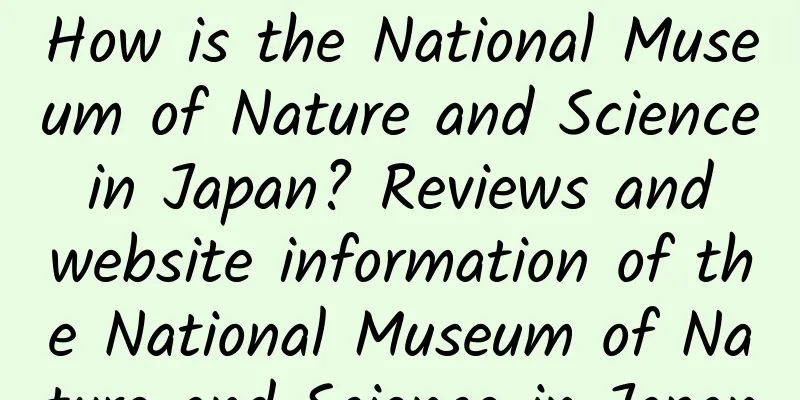How is the National Museum of Nature and Science in Japan? Reviews and website information of the National Museum of Nature and Science in Japan

|
What is the website of the National Museum of Nature and Science? The National Museum of Nature and Science is a science museum in Japan. It was formerly an educational museum and was founded in 1877. It is located in Tokyo. The main purpose of the establishment of the National Museum of Nature and Science is to popularize natural science and social education. Website: www.kahaku.go.jp Explore the National Museum of Nature and Science: A Palace of Natural Science and Social EducationAs one of the oldest and most influential science museums in Japan, the National Museum of Nature and Science has been committed to popularizing natural science knowledge and social education since its establishment in 1877. This museum in Tokyo is not only a place to display the mysteries of science and nature, but also an important place to stimulate people's curiosity and cultivate scientific literacy. This article will comprehensively introduce the historical background, exhibition content, educational activities and important position of the National Museum of Nature and Science in modern society. Historical Origins: From Educational Museum to Palace of ScienceThe origin of the National Museum of Nature and Science can be traced back to the Meiji Restoration. At that time, in order to promote modernization and educational reform, the Japanese government established the "Education Museum" in 1877, which was the predecessor of the National Museum of Nature and Science. The original Education Museum was established in the University of Tokyo, with the main purpose of disseminating scientific knowledge to the public by displaying specimens and objects. As time went by, the museum expanded in size and its exhibitions became more diverse. In 1949, the Education Museum was officially renamed the National Science Museum and became an independent institution. During this period, the museum began to focus on research and exhibition in the field of natural sciences, while also strengthening its emphasis on social education. Today, the National Museum of Nature and Science has become one of the most important science museums in Asia and even in the world. It not only houses a large number of precious specimens and artifacts, but also attracts tourists and scholars from all over the world through a variety of exhibitions and activities. The museum's official website ( www.kahaku.go.jp ) provides the public with detailed exhibition information, event arrangements, and online resources, allowing more people to understand and participate. Exhibition content: The intersection of nature and scienceThe exhibitions at the National Museum of Nature and Science cover a wide range of fields, including earth sciences, life sciences, anthropology, and the history of science and technology. These exhibitions allow visitors to gain a deeper understanding of the mysteries of nature and the development of science through vivid displays and interactive experiences. 1. Earth Science Exhibition Area: This exhibition area displays the formation, evolution and geological phenomena of the earth. Visitors can learn about the internal structure of the earth and the movement of plates by observing various rock and mineral specimens. In addition, the exhibition area also has a simulated earthquake experience area, allowing visitors to experience the power of earthquakes and enhance disaster prevention awareness. 2. Life Science Exhibition Area: The Life Science Exhibition Area is one of the core parts of the museum, where various biological specimens from microorganisms to large mammals are displayed. Through lifelike models and multimedia displays, visitors can learn about the diversity of life and its evolution. It is particularly worth mentioning that the museum also has a dinosaur fossil exhibition area, which displays some precious dinosaur bone fossils, attracting many dinosaur enthusiasts. 3. Anthropology Exhibition Area: The anthropology section explores the origin and development of humans. Ancient human skeletal fossils, tools, and artworks are displayed here to help visitors understand the evolution of human civilization. In addition, the exhibition area also introduces the uniqueness of Japanese native culture and displays the restored scenes of the ancient Japanese lifestyle. 4. History of Science and Technology Exhibition Area: The History of Science and Technology exhibition area reviews the development of science and technology, and displays various achievements from ancient inventions to modern high technology. Through interactive devices and multimedia presentations, visitors can experience firsthand how the advancement of science and technology has changed our lives. Educational activities: the cradle of scientific literacyIn addition to its rich exhibition content, the National Museum of Nature and Science also actively carries out various educational activities aimed at cultivating the public's scientific literacy and innovation capabilities. These activities are aimed at audiences of different ages, including interesting science courses for children and in-depth lectures and seminars for adults. 1. Children's Education Project: The museum has designed a series of entertaining and educational activities for children, such as science experiment workshops, nature observation tours, etc. These activities stimulate children's interest in science and their spirit of exploration through hands-on practice and interactive communication. 2. Adult Education Programs: For adults, museums provide more professional and in-depth learning opportunities. For example, regularly held special lectures invite well-known scientists to share their latest research results; scientific seminars provide professionals with a communication platform to promote interdisciplinary cooperation and innovation. 3. School Cooperation Program: The museum works closely with schools to develop a series of resources and activities suitable for classroom teaching. Teachers can lead students to visit the museum and use the educational resources in the museum for on-site teaching. This teaching method that combines theory and practice has greatly improved students' scientific learning effects. Innovation in the digital age: the integration of online and offlineWith the rapid development of digital technology, the National Museum of Nature and Science is also actively exploring new models that combine online and offline activities to better meet the needs of the public. The museum's official website ( www.kahaku.go.jp ) not only provides detailed exhibition information, but also launches a virtual tour function, allowing visitors who cannot visit the museum in person to enjoy the museum's wonderful exhibits online. In addition, the museum has developed a variety of digital educational resources, such as interactive e-books, virtual reality experiences, etc., to provide learners with a richer and more flexible way of learning. These digital tools not only break through the limitations of time and space, but also enhance the fun and interactivity of learning. Social impact: promoting the popularization of science and cultural inheritanceAs one of the most important science museums in Japan, the National Museum of Nature and Science has played an important role in promoting the popularization of science and cultural heritage. Through a variety of exhibitions and educational activities, the museum has successfully transformed complex scientific knowledge into easy-to-understand content, enabling more people to understand and appreciate the charm of science. At the same time, the museum is also actively involved in international cooperation, carrying out research and exhibition projects with scientific institutions in other countries. This cross-border cooperation not only promotes the sharing of scientific knowledge, but also builds a bridge for cultural exchanges around the world. Future Outlook: Direction of Continuous Innovation and DevelopmentIn the face of ever-changing social needs and technological progress, the National Museum of Nature and Science will continue to be committed to innovation and development. In the future, the museum plans to further expand its exhibition content and introduce more research results in cutting-edge scientific fields; at the same time, it will strengthen digital construction and provide more high-quality online resources and services. In addition, the museum will continue to deepen cooperation with all sectors of society to jointly promote the development of scientific education and cultural communication. Through these efforts, the National Museum of Nature and Science hopes to become a bridge between science and the public, and inspire more people to be interested in and love natural science. ConclusionThe National Museum of Nature and Science is not only a place to showcase the mysteries of science and nature, but also an important base for cultivating scientific literacy and inheriting culture. Whether through on-site visits or online experiences, everyone who comes here can feel the charm of science and the power of knowledge. Let's walk into the National Museum of Nature and Science together and start a journey full of surprises and discoveries! |
<<: How is Thai Nok Air? Thai Nok Air Reviews and Website Information
>>: What is BioWare like? BioWare review and website information
Recommend
What are the uses of snow?
After entering winter, the weather is cold and it...
How is the Chinese Embassy in Angola? Reviews and website information of the Chinese Embassy in Angola
What is the website of the Chinese Embassy in Ango...
International Renewable Energy Agency_What is IRENA like? International Renewable Energy Agency_IRENA reviews and website information
International Renewable Energy Agency_What is IREN...
The benefits of hand-peeled pine nuts
Many people in our lives have a special liking fo...
The difference between oranges and tangerines and the benefits of eating oranges
Oranges and tangerines look exactly the same in a...
The advantages and disadvantages of eating oats for a long time
Oats are a kind of food that people often eat, es...
How to make roxburgh juice
Ripe roxburghii is usually yellow in color, and i...
How is Bulgaria Air? Bulgaria Air Reviews and Website Information
What is Bulgaria Air? Bulgaria Air is the national...
Ingredients and steps for braised pork trotters
Many people like to order a dish of braised pork ...
How to nourish the kidney with diet What foods can men eat to nourish the kidney
If the kidneys are not in good condition, it mean...
How is Ford Rock? Ford Rock review and website information
What is Foot Locker? Foot Locker is the world'...
The advantages and disadvantages of eating grapes regularly
With the arrival of summer, grapes, a delicious f...
The efficacy of dried oyster porridge
How much do you know about the effects and functi...
How is G-Speed? G-Speed Review and Website Information
What is GSeeker? GSeeker is a famous website: www....
What is Barrett Firearms? Barrett Firearms Reviews and Website Information
What is Barrett Firearms Manufacturing? Barrett Fi...









